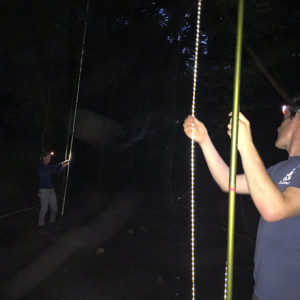The IBCP has finished work at our first mist-netting site, in the southern portion of Kickapoo State Park (Vermilion County, Illinois). Mist-netting is a term used for the method of capturing bats using a large net made up of very fine threads. These nets have to be extremely inconspicuous because not only do bats have good eyesight, but they also use echolocation to identify obstacles. Mist-netting is important because it allows bat biologists to study bats in hand. While mist-netting is more invasive for bats than acoustic monitoring, handling bats provides important information that we cannot get from acoustic monitoring, such as age, sex, and reproductive status.

Mounted on aluminum poles, our mist-nets stretch across the width of the stream.
For mist-netting to be successful, nets have to be placed in areas where bats are likely to fly. Bat activity tends to be high at locations with water at sunset because bats will dip down to the water’s surface to drink as they fly. Bodies of water are also important as feeding sites, because many species of insects concentrate their activity around water. We tend to place mist nets in flight corridors because this is where landscape features help funnel bats into the nets. Flight corridors, including roads, creeks, rivers, and trails, are areas where bats can easily fly through otherwise cluttered forests to hunt their prey.
Our mist-netting site at Kickapoo State Park is both a water source and a flight corridor. Set up over a small stream, our nets were positioned in the open space above the stream bed. The nets we use are double-high, meaning that each set-up reaches from near the water surface to almost 18 feet in the air. Filling most of the space over the stream and between the surrounding trees, double-high mist nets are likely to capture any bats flying in the corridor above the stream.

The very fine threads that make up a mist-net can become easily tangled if not carefully handled.
Downstream of the mist nets was our processing station- where the IBCP biologists measure identifying characteristics of each bat and identifying the species before releasing the bat. The processing station was placed around a bend in the stream from the mist nets, preventing light from the station from shining on the nets.
Unfortunately, no bats were captured in our two nights of mist-netting at Kickapoo State Park. With the massive bat die-offs caused by White-Nose Syndrome, there are fewer bats to be captured by mist-netting. Despite this frustration, the important data collected on successful nights of mist-netting makes the nights we’re “skunked” worth it.

